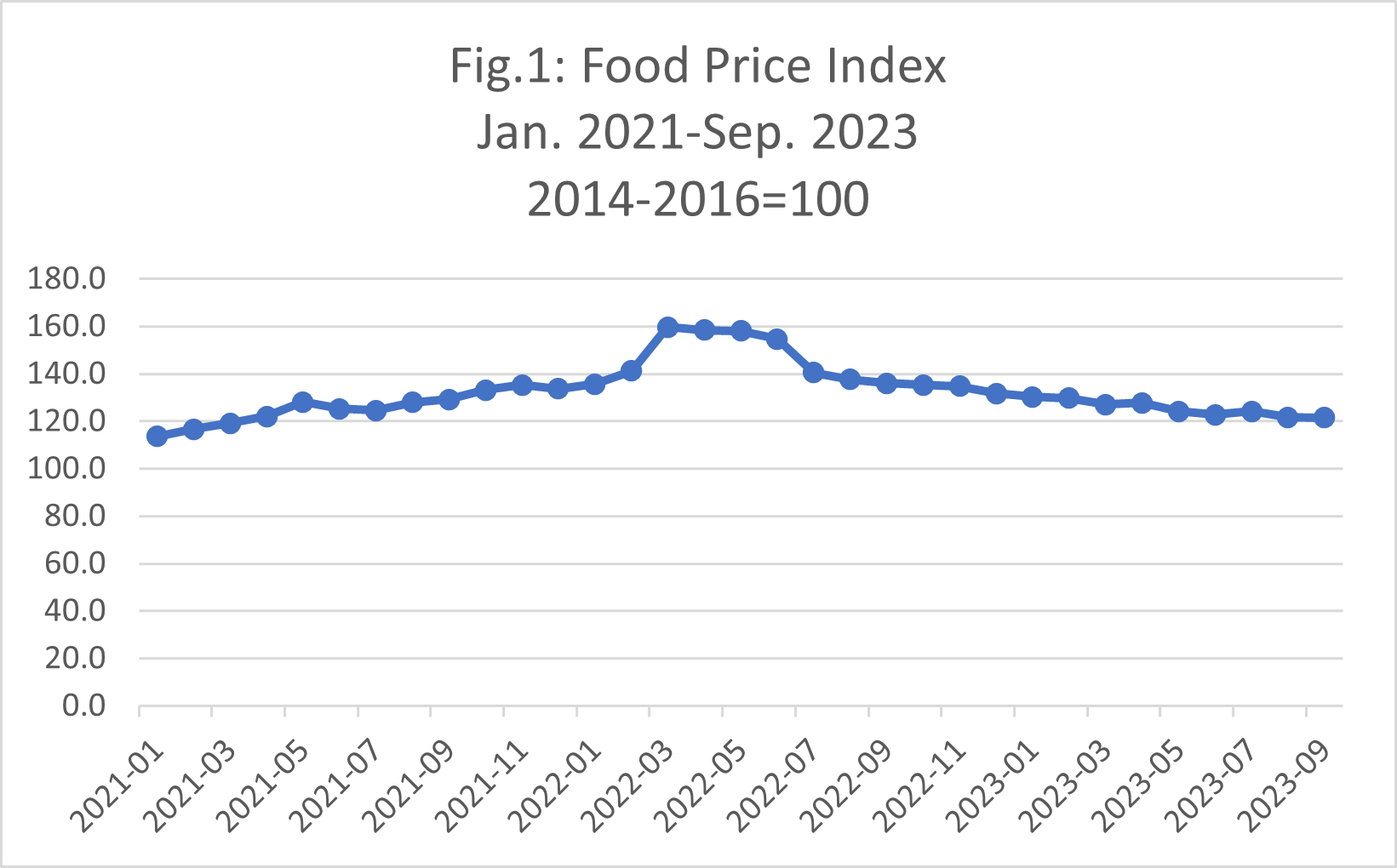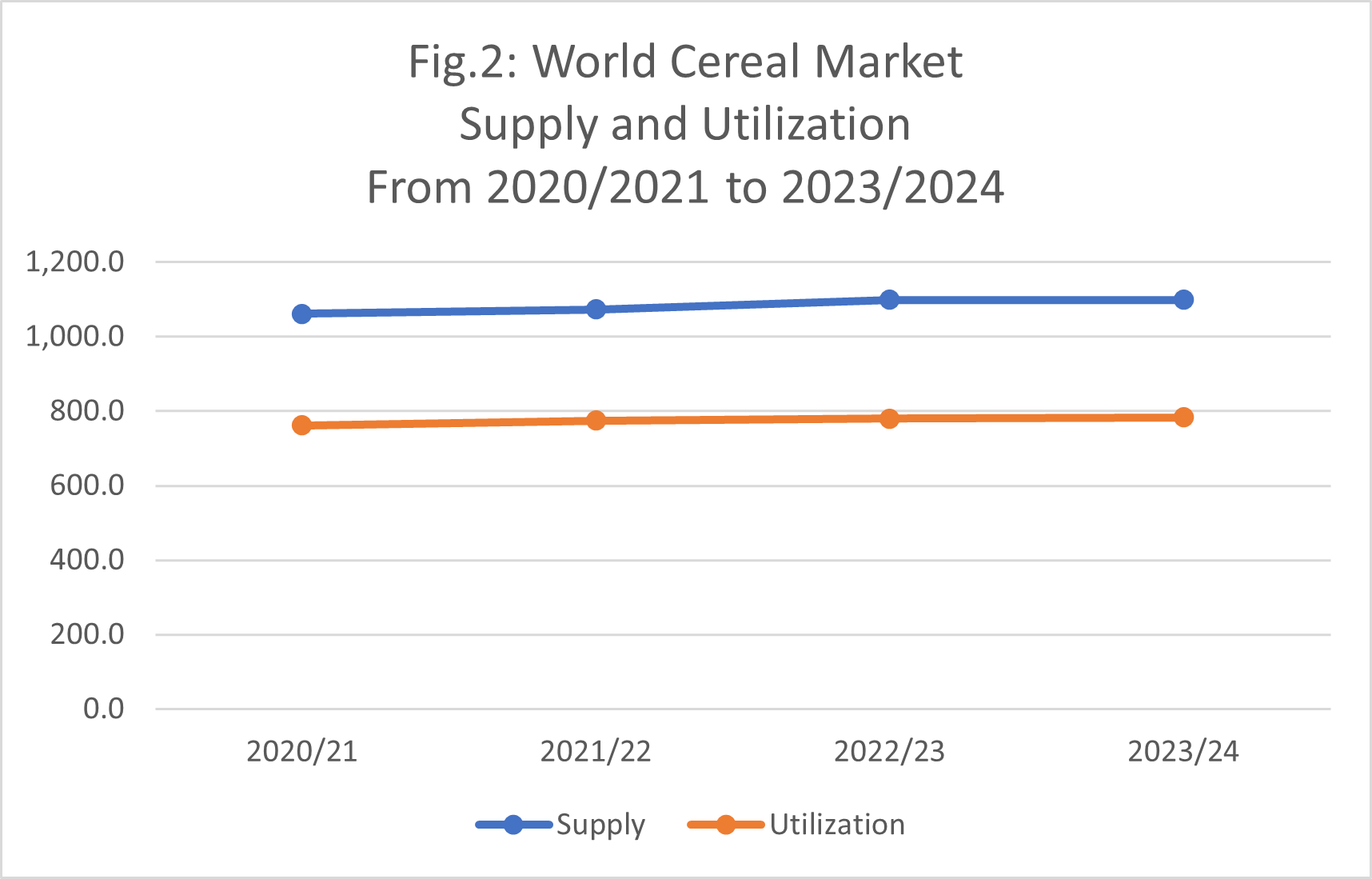An Examination for the External Causes of Rising Food Prices in Japan
10/15 2023
Author: Naoto Yoshikawa
First, as for global food prices in (1), as shown in the graph below, the Russian invasion of Ukraine in February 2022 caused food prices to rise for less than six months. Since then, however, food prices have fallen after once rising, and now prices have settled down to almost pre-war levels (FAO 2023/b). Given this current state of food prices on the international market, it is likely that food prices on the global market have not led to the recent increase in food prices in Japan.

(2) This price settle-down also indicates that food supplies meet global demand. If food production were declining due to extreme weather conditions and supply were not meeting international market demand, food prices would rise, but this has not been the case. In the case of the most critical, market-driven product, grain, let’s look at the relationship between food supply and food demand in the international market. As shown in Figure 2 below, from 2020/2021 to 2023/2024, the amount of food supplied to the market is much larger than the amount demanded (utilization) (FAO/a).

In this year, 2023, while some parts of Canada, Australia, the EU, and Argentina have experienced lower grain harvests due to locally bad weather, Ukraine and Kazakhstan have increased grain production, leading to some offsets (USAID 2023, 1). The impact on the international market does not appear to be significant. The forecast for grain supply in 2024 shows that the supply of grains in 2024 indicates some stock reduction but no change in market supply (USAID 2023, 1, and FAO 2023/a). In other words, it is unlikely that the price increase due to reduced food production caused by Russia’s invasion of Ukraine and/or localized terrible weather is a factor in why food prices are rising in Japan, as is generally believed. (Although current supplies and prices are not guaranteed until the war ends.)
(3) Energy prices on the international market have been rising since April 2020, reaching a peak in August 2022 (573.48% higher than in April 2020), and are now 236.85% higher as of August 2023 than the price in April 2020, even though they have calmed somewhat (FRED 2023). It is unlikely that prices will return to 2020 levels in the near future. It is easy to see how Japan, which relies on imports for 62% of the total food consumption of calories, could be directly affected by the higher transportation costs of these imports (MAFF 2023). In addition, energy costs, including electricity, account for 25% of food production value in Japan (ANRE 2023). Considering that 25% of food production cost is energy cost, which has risen significantly, it would be fair to say that the rise in energy prices is a significant factor in the increase in food and food production prices.
Regarding the depreciation of the yen in (4), a comparison of the US dollar and exchange rate between January 2020 and October 2023 shows a 37% decrease in the value of the Japanese yen (Google Finance 2023). Japan also depends on imported food for 42% of the total food production value (MAFF 2023). Therefore, imported food and food products are in a situation where a price increase is unsurprising. The yen depreciation is undoubtedly another factor contributing to the rise in food and food product prices.
To this point, the external factors behind the rise in Japan’s food and food product prices have been examined, and the supply and prices of food in the international market have hardly changed and affected the food prices in Japan. We can speculate that the following factors may be responsible for the price rise.
- The increase in transportation costs of food imports is due to rising energy prices, which directly affects food price increases. In addition, energy costs account for 25% of the food production value in Japan (ANRE 2023). Therefore, the rise in energy prices strongly and negatively impacts food prices.
- The depreciation of the yen has had a substantial impact on the actual value of imported food and food products in the Japanese yen. The yen depreciation has increased domestic energy prices in yen value, which is notably increasing the food production cost since 25% of total food production cost is the energy cost in Japan, as mentioned above.
There seems to be no doubt that higher energy prices on the international market and a weaker yen exchange rate are having an impact on the rising prices of food and food products in Japan.
Reference
Agency for Natural Resources and Energy (ANRE) (2023) “Enerugi Hakusho 2023 (Energy White Paper 2023),” ‘Dai 3 Setsu: Sekaitekina Enerugi no Kouto ga Nihon ni Ataeru Eikyo : [133-2-2] Kakugyosyu no Seisangaku ni Shimeru Enerugi Kosto no Wariai (Impact of Rising Global Energy Prices on Japan: [133-2-2] Energy Costs as a Percentage of Production Value for Each Industry ),’ (26 July 2023) https://www.enecho.meti.go.jp/about/whitepaper/2022/html/1-3-3.html (last visited, 8 October 2023)
Federal Reserve Bank of St. Louis Economic Research Economic Data (FRED) (2023) ‘Global price of Energy index (PNRGINDEXM).’ (13 September 2023) https://fred.stlouisfed.org/series/PNRGINDEXM (last visited, 8 October 2023)
Food and Agriculture Organization of the United Nations (FAO) (2023/a) ‘FAO Cereal Supply and Demand Brief.’ (6 October 2023)
https://www.fao.org/worldfoodsituation/csdb/en (last visited, 8 October 2023)
Food and Agriculture Organization of the United Nations (FAO) (2023/b) ‘World Food Situation: FAO Food Price Index.’ (6 October 2023)
https://www.fao.org/worldfoodsituation/foodpricesindex/en (last visited, 8 October 2023)
Google Finance (2023) ‘America Gashukoku Doru kara En (From US Dollar to Japanese Yen),’ (8 October 2023)
https://www.google.com/finance/quote/USD-JPY?sa=X&ved=2ahUKEwjjhreBtOBAxWPNd4KHYmrCHYQmY0JegQIBhAr&window=5Y (last visited, 8 October 2023)
Ministry of Agriculture, Forestry and Fisheries (MAFF) (2023) ‘Nihon no Shokuryo Jikyuritsu (Japan’s Food Self-Sufficiency Ratio)
https://www.maff.go.jp/j/zyukyu/zikyu_ritu/012.html (last visited, 8 October 2023)
Ministry of Internal Affairs and Communications (MIC) (2023) ‘2020 nen Kijun Shohisha Buttukashisu: Zenkoku 2023 nen 8 gatsubun (Consumer Price Index the Base of 2020: Nationwide for August 2023).’ (22 September 2023) https://www.stat.go.jp/data/cpi/sokuhou/tsuki/pdf/zenkoku.pdf (last visited, 8 October 2023)
US Department of Agriculture (USAID) (2023) ‘World Agricultural Supply and Demand Estimates WASDE - 640,’ (12 September 2023) https://www.usda.gov/oce/commodity/wasde/wasde0923.pdf (last visited, 8 October 2023)
